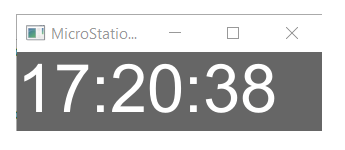
Clock using PyQt
Q How do I pop a dialog with a clock using MicroStation Python?
A Here's a small Python program that uses the PyQt library. It shows a small dialog that displays a digital clock inside the MicroStation window …

Python Implementation
Here's the Python source code of the clock. It is derived from the Python clock example delivered with MicroStation 2024 …
# MicroStationClockRevised.py import sys import PyQt5 from PyQt5.QtWidgets import * from PyQt5.QtWidgets import QMainWindow, QApplication from PyQt5.QtCore import QTimer, Qt from PyQt5.QtGui import QFont, QWindow import time import os from MSPyBentley import * from MSPyBentleyGeom import * from MSPyECObjects import * from MSPyDgnPlatform import * from MSPyDgnView import * from MSPyMstnPlatform import * # # This is a modified version of the Clock example delivered with MicroStation Python examples. # I modified it because I found the use of timers very confusing: the original has two timers, both named 'timer'. # One timer is the the clock that you can see when the app is active. # The other timer is the one discussed below that enable the app and MicroStation to share the Windows messages. # I've renamed the timer variables to make clarify their use: 'clockTimer' and 'messageLoopTimer' # # This demonstrates a PyQt5 UX window containing a clock which doesn't block # the execution of MicroStation's input loop. # # Using Python call app.exec will not return out of the loop until the PyQt5 window is closed, this blocks # the main application thread of MicroStation. Qt is a C based Ux framework whose timers will execute in the main event loop for the UX framework # # Registering a timer with a 0 start interval will cause the timer method to execute every time the Qt Windows event loop finishes. # Calling PyCadInputQueue.PythonMainLoop from the timer will allow MicroStation's input loop to execute allowing use of the # MicroStation UX whilst the Qt window is displayed. # def dump(obj): for attr in dir(obj): print("obj.%s = %r" % (attr, getattr(obj, attr))) class MainWindow(QMainWindow): # Initialize the main window class def __init__(self): # Call the parent class's constructor to initialize the main window super().__init__() # Set the title of the main window self.setWindowTitle("MicroStation PyQt5 Clock") # Set the background color of the main window self.setStyleSheet ( 'background-color: #666666;' # hex code for medium gray ) # Set the size of the main window (x, y, width, height) self.setGeometry ( 0, # initial x-coordinate 0, # initial y-coordinate 240, # width in pixels 80 # height in pixels ) # Make the main window stay on top of other windows self.setWindowFlags (Qt.WindowStaysOnTopHint) # Create a QLabel widget for displaying the clock time self.label = QLabel ( time.strftime("%H:%M:%S"), # format string for 24-hour time display self # parent widget is the main window ) # Set the text color of the label to white self.label.setStyleSheet ('color:white;') # Set the font of the label to Arial with size 40 self.label.setFont ( QFont ("Arial", 40) # font family and size ) # Adjust the size of the label widget to fit its contents self.label.adjustSize () # Create a QTimer object for updating the clock time #self.timer = QTimer (self) self.clockTimer = QTimer (self) # Connect the timer's timeout signal to the updateClock method self.clockTimer.timeout.connect (self.updateClock) # Start the timer with an interval of 1 second (1000 milliseconds) self.clockTimer.start (1000) def updateClock(self): self.label.setText (time.strftime("%H:%M:%S")) def updateMstn (): PyCadInputQueue.PythonMainLoop() def MessageLoopTimer (): # Timer updates MicroStation each second to ensure that this Python window does not monopolise the message loopx messageLoopTimer = QTimer() # create a QTimer object for updating the message loop messageLoopTimer.timeout.connect(updateMstn) # connect the timer's timeout signal to the updateMstn function messageLoopTimer.start() # start the timer with an interval of 1 second (1,000 milliseconds) if __name__ == "__main__": # check if this script is being run directly (not imported as a module) app = QApplication.instance() # get the existing application instance, if any if app is None: # check if no application instance exists app = QApplication(sys.argv) # create a new application instance with command-line arguments window = MainWindow() # create an instance of the main window class window.show() # show the main window # Timer updates MicroStation each second to ensure that this Python window does not monopolise the message loop MessageLoopTimer () app.exec() # run the application's event loop until the window is closed
Questions
Post questions about MicroStation programming to the MicroStation Programming Forum.